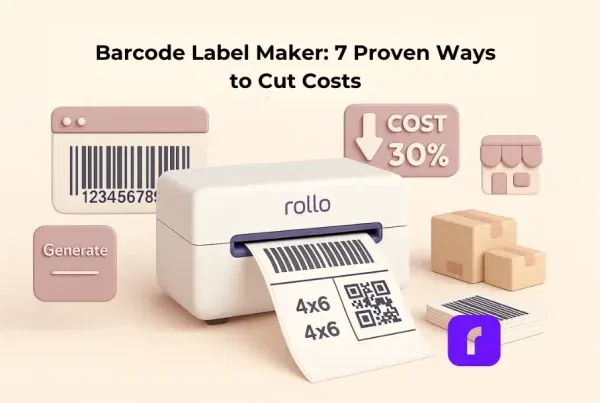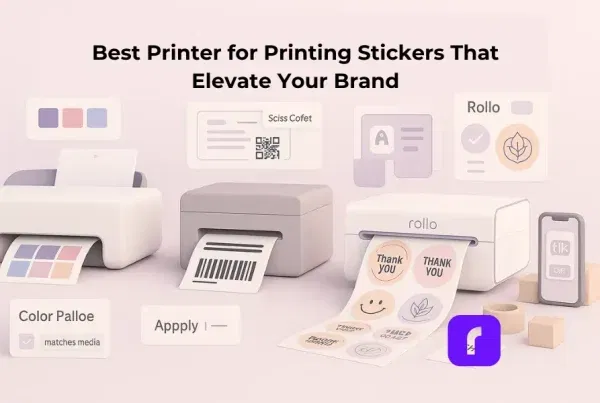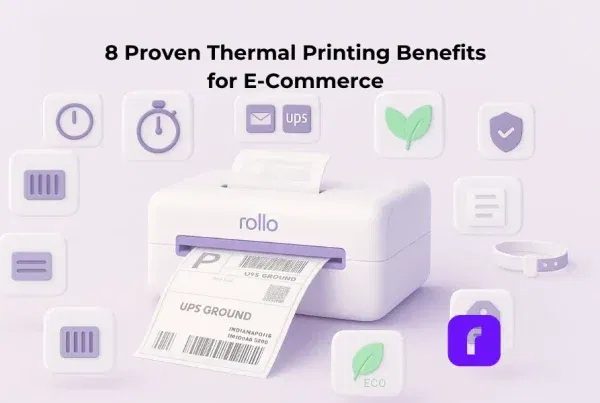USPS label printing lets you create prepaid shipping labels online, attach them to parcels, and hand them to your carrier without extra forms. The quickest, most cost‑effective workflow is to import orders into commercial‑rate software (such as Rollo Ship), compare USPS and UPS prices, batch‑print 4 × 6 thermal labels, and finish with one SCAN form for instant acceptance.
Small businesses feel every penny, and the July 2025 USPS rate jump— 6.3 % higher for Priority Mail and up to 21 % for Ground Advantage—hits hard. Add the maddening “label shows delivered before it even ships” glitch, and usps label printing can feel like an obstacle course. If you’re spending precious minutes re‑entering order info, swapping ink cartridges, or guessing which service is still affordable, this guide is for you.
We’ll break down what really changed, show side‑by‑side costs, and share battle‑tested tips that let you batch‑print 100 labels in three minutes. Along the way, you’ll see how tools like Rollo Ship and a wireless thermal printer can trim costs and stress—so you can ship faster, satisfy customers, and keep more profit in your pocket.
Key Takeaways
What Changed in USPS Label Printing for 2025?
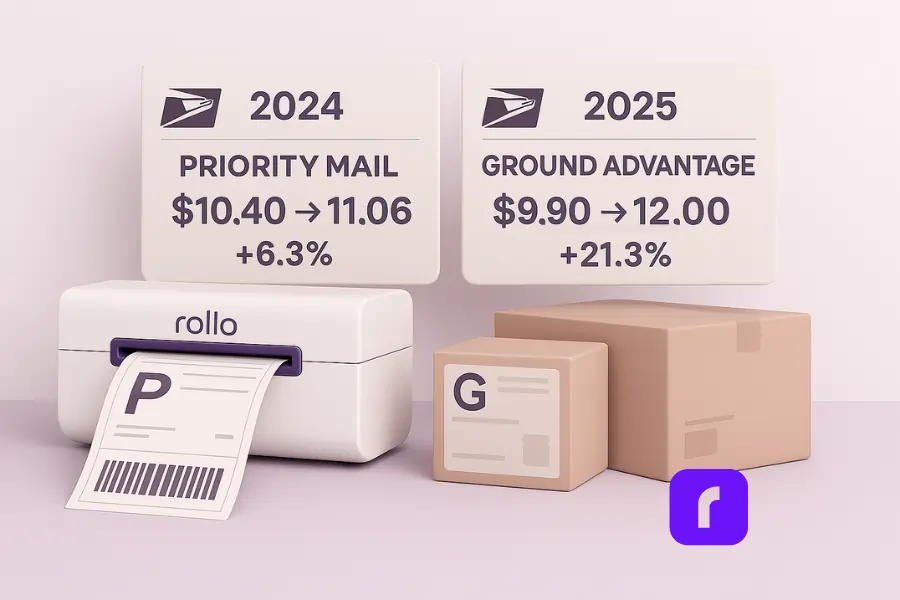
USPS announced new shipping service prices effective July 14, 2025, with increases across key products. These adjustments impact budget-sensitive sellers most—especially those shipping 1–6 lb packages in Zones 3–6. Some sellers are also reporting a tracking glitch that marks packages “Delivered” the moment a label is created.
Here’s how those pricing changes stack up—and why using commercial shipping software like Rollo Ship is more important than ever.
📊 USPS Rate Snapshot (Retail Online Prices)
| Service & Package Example | 2024 Base Rate | 2025 Base Rate | % Increase |
|---|---|---|---|
| Priority Mail (2 lb, Zone 5) | $10.40 | $11.06 | +6.3 % |
| Ground Advantage (4 lb, Zone 4) | $9.90 | $12.01 | +21.3 % |
Source: USPS 2025 Rate Announcement
Rate-Hike Snapshot (July 2025)
📦 Priority Mail saw a 6.3% jump across weight classes
📈 Ground Advantage hikes reach $2.11 per package on popular 1–6 lb tiers
💸 Irregular-package surcharges and non-standard size fees add even more
🗓️ New rates went live July 14, 2025, as part of the Postal Service’s mid-year adjustment
“Delivered-Before-Shipped” Tracking Error
According to an eBay seller forum post and official update, some USPS label printing jobs—particularly when labels are purchased through eBay or other platforms—are triggering a false “Delivered” status immediately after printing. This glitch has caused confusion and refund requests from buyers.
Until USPS resolves the issue, sellers using platforms like Rollo Ship can rely on real-time scan updates and detailed USPS label printing history logs to reassure customers and protect their performance metrics.
Which Method Is Best for Printing USPS Shipping Labels?
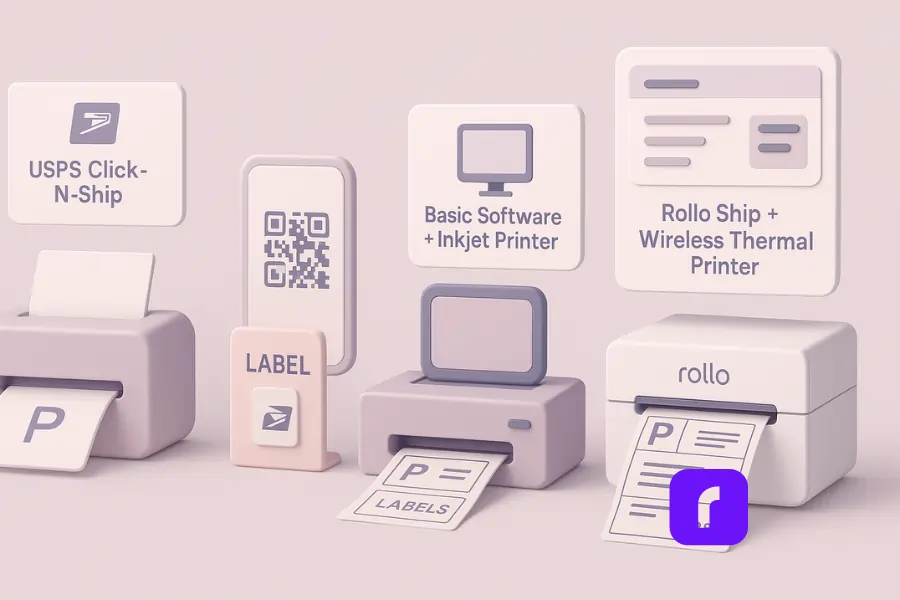
Need a quick cheat‑sheet for USPS label printing? These are the four main ways to print USPS labels, ranked from basic to pro. Pick the one that matches your volume, budget, and tech setup:
- USPS Click‑N‑Ship – Good for the occasional parcel; pay online and print on any home printer.
- Label Broker QR code – No printer? Generate a code, scan it at the Post Office, and they’ll print for you.
- Create the Label at the Post Office – Fill out a shipping form or use a self‑service kiosk, pay full retail rates, and wait while staff prints the label; no batch tools or order tracking integrations.
- Rollo Ship + Wireless Thermal Printer – Batch shipping labels in minutes, unlocks discounted rates, and eliminates ink entirely.
Method 1: USPS Click‑N‑Ship
- 🖥️ Free USPS portal; pay retail or Commercial Base rates.
- 🧾 Prints labels one by one on standard paper.
- 📦 Best for <10 packages a week; limited batch features.
- 🔍 No built‑in multi‑carrier comparison.
Method 2: Label Broker (Printer‑Free)
- 📲 Generates a Label Broker QR code you show at the counter.
- 🚶♂️ Great emergency option, but you’ll still stand in line.
- 💵 Adds $1.55 per label if you ask USPS to print and deliver it.
- 📂 No order management or bulk tools.
Method 3: Basic Software + Inkjet Printer
- 📊 Modest discounts and simple tracking
- 🖨️ Uses inkjet or laser paper sheets
- 🔢 Batch limit around 50 labels
- 🔗 Few platform integrations
Method 4: Rollo Ship + Wireless Thermal Printer
- 🔄 Imports orders from Shopify, Amazon, eBay—no retyping.
- ⚡ Batch shipping labels: print 100+ 4 × 6 labels in about three minutes.
- 💼 Access Commercial + negotiated USPS rates and instant UPS comparisons.
- ♻️ Heat‑based printing means zero ink costs; wireless setup frees your workspace.
- 📦 Live tracking updates keep buyers in the loop—even when USPS scans glitch.
With these USPS label printing options on the table, you can see how speed and savings rise as you move toward Method 4. But how much cash does the upgrade really put back in your pocket? Let’s crunch the numbers and uncover the biggest money‑saving tricks next.
Money‑Saving Tips: How to Slash USPS Label Printing Costs
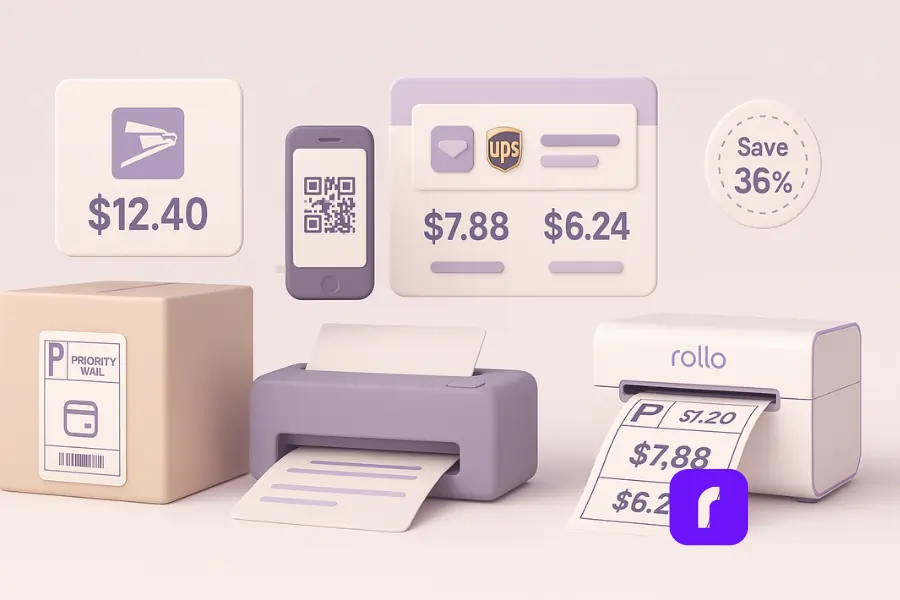
Sticker shock is real. Retail postage can eat 15 %–20 % of an online order’s margin, yet most sellers never tap into commercial USPS rates or true multi‑carrier rate shopping. The fix isn’t fancy accounting; it’s smarter software. By using Rollo Ship for your USPS label printing, you unlock up to 90% off published USPS prices and can compare those savings against real-time UPS offers—all in one dashboard. Just a few minutes of setup can put thousands back into your profit column.
| Savings Scenario* | Avg. 2025 Retail | Rollo Ship Price | Your Gain |
|---|---|---|---|
| 4 lb Priority Mail (Zone 5) | $12.40 | $7.88 | 36 % |
| 2 lb Ground Advantage (Zone 4) | $9.20 | $6.24 | 32 % |
*Sample Commercial and negotiated rates; actual discounts vary by zone and weight.
Tip #1: Unlock Commercial Rates
- 💼 Sign up for any approved shipping platform—Rollo Ship activates Commercial Base automatically.
- 🧾 No volume contract needed; even one label qualifies.
- 📦 USPS label printing savings stack further on medium and large flat‑rate boxes.
- 📊 Review bills monthly; USPS may add new classes to its commercial table.
Tip #2: Compare USPS vs UPS in One Click
- 🔄 Open the multi‑carrier tab in Rollo’s dashboard and enter weight once.
- 📉 The widget shows cheapest, fastest, and eco score side by side—zero spreadsheets.
- 🚚 Many 1‑ to 5‑day UPS® Ground lanes undercut Ground Advantage after July’s hike.
- 🖼️ Screenshot: Insert a side‑by‑side rates image (Rollo dashboard) to prove the point.
When you can compare USPS and UPS in the same view, you stop overpaying and start shipping smarter. These money-saving tips alone can make a big difference—but when speed matters just as much as cost, the right printing setup can push your workflow even further.
🚀 Ready to lock in up to 90 % off USPS rates?
Click below to create your free Rollo Ship account
and start printing discounted labels in minutes.
Speed‑Boosting Tips: Print 100 Labels in 3 Minutes
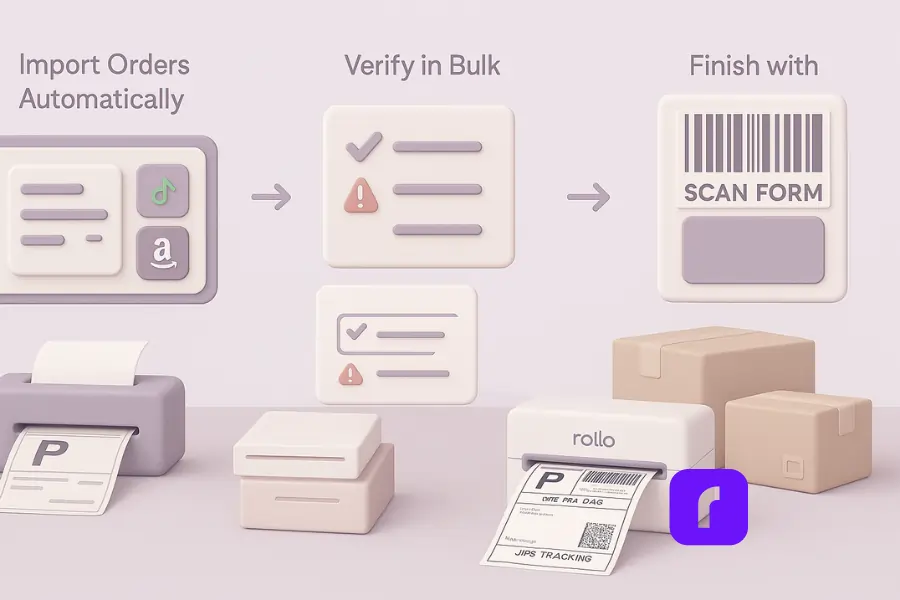
Need orders out the door—fast? Follow this four-step USPS label printing workflow to batch your shipping labels without breaking a sweat. (See the embedded GIF of the Rollo dashboard + wireless printer cranking through a stack in real time.)
- Import orders automatically. One click pulls every pending sale into the dashboard—no copy‑paste, no CSV drama.
- Verify weights & addresses in bulk. The system flags odd zip codes and suggests the cheapest class before you waste labels.
- Batch‑print the entire queue. Hit “Print All” and watch 4 × 6 labels fly—100 labels roll out in about three minutes on thermal.
- Close with a SCAN form. Generate one barcode for the clerk to zap; every parcel in the batch shows as “Accepted” the moment it’s scanned.
Tip #3: Batch‑Print Shipping Labels With Thermal
- 🖨️ Swap inkjet sheets for a USPS‑ready wireless thermal printer—labels emerge dry, sharp, and peel‑ready.
- ⚡ The Rollo Wireless Printer hits 150 mm/s, quick enough to match high‑volume pick lists.
- 🚫 Thermal tech means zero cartridges, so you’re never stuck mid‑run.
⚡ Upgrade Your Setup in One Click
Ready for ink‑free, 150 mm/s printing?
Tip #4: Automate Order Imports
- 🔌 Selling on Shopify, TikTok Shop, or Amazon? Flip the toggle in Rollo Ship once.
- 📥 Every new order drops into the queue automatically—no manual entry needed.
- ✅ You walk in, hit print, and start packing—no spreadsheets, no wasted time.
With automation and batch printing dialed in, you’re not just saving time—you’re building a system that scales with your business. The fewer clicks it takes to complete USPS label printing, the more time you can spend growing your store, not fighting your printer.
Quality Tips: Avoid Common USPS Label Errors
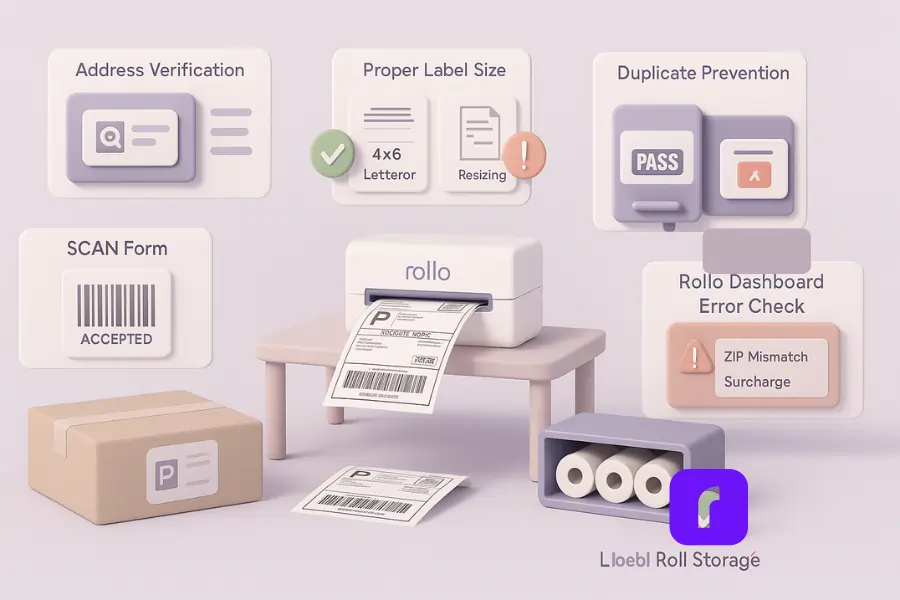
Before you slap a label on the box, run through this quick USPS label printing checklist to dodge re-scans, returns, and refunds:
- 📬 Address verification first. Make sure every line passes the USPS database; fixing typos now beats paying double for reroutes.
- 🏷️ Stick to 4 × 6 thermal stock. Resizing PDFs to letter paper causes barcode misreads and wastes labels.
- 🔧 Calibrate darkness and alignment weekly. Crisp edges keep barcodes machine‑readable; fuzzy prints head to manual sorting.
- 👀 Preview each batch for duplicates. A missed cancel means two shipments and instant label waste.
- 📑 Generate a daily SCAN form. One barcode marks every parcel accepted, sidestepping the dreaded shipping label glitch.
- ✅ Use Rollo’s error‑proof verification. Wrong weight, ZIP mismatch, or Sunday surcharge? The dashboard flags it before you print.
- 🧊 Store rolls flat in a cool drawer. Heat or pressure curls labels and can jam the printer mid‑run.
Following these USPS label printing best practices keeps packages moving fast and customers happy. Plus, when Rollo’s built-in checks catch errors upfront, you’re not eating the cost of reships—or the time lost fixing avoidable mistakes. A few extra seconds here save hours down the line.
Savings Snapshot: How Much Can You Keep?
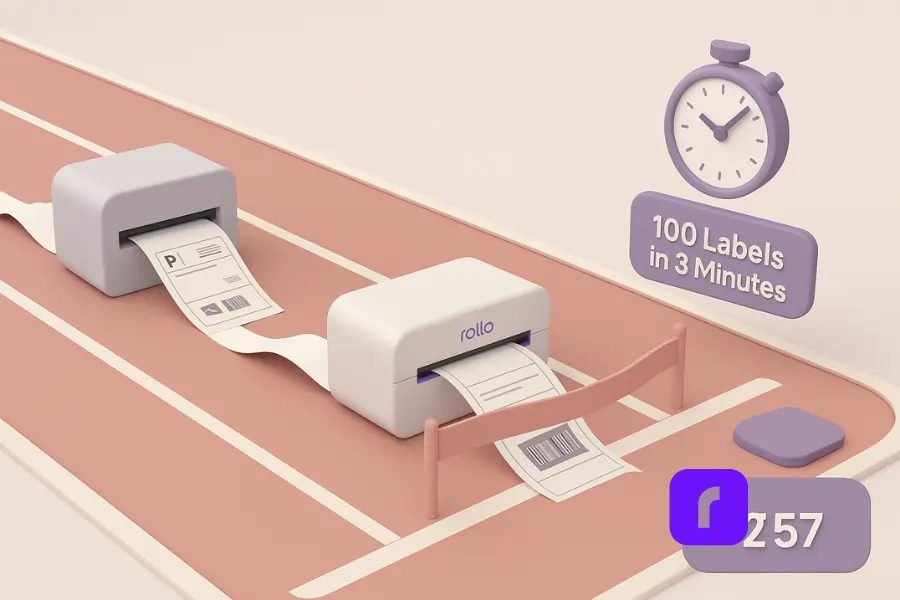
Switching to a thermal USPS label printing workflow with Rollo Ship does two things—cuts postage and slashes packing time. Scan the table, then see how real merchants turned those percentages into real money.
| Metric | Before (Inkjet + Retail) | After (Rollo Ship + Thermal) | % Change |
|---|---|---|---|
| Labels per hour | 40 | 120 | +200 % |
| Avg. postage per 4 lb parcel | $12.40 | $7.88 | –36 % |
| Labor minutes saved (100 labels) | — | 80 | 80 min |
| Projected yearly savings* | — | $4,200 | — |
*Assumes 100 labels/day, 5 days/week.
Real‑World Wins: Seller Success Stories
- 🏋️ Loungefit Apparel (Andre) — Batch‑prints all Shopify orders on the wireless Rollo in one session, trimming pick‑and‑pack shifts by 40 %. Postage discounts helped fund the launch of a new comfort collection without raising prices.
- 🧶 Happy Rugs (Madeline) — Went from hand‑writing labels to printing 100 in the time it used to take for 10. Rollo cut label prep to 15 minutes a day, freeing more time to design custom punch‑needle rugs for her viral TikTok audience.
- 🍭 Floof Cotton Candy (Hannah) — Switched to Rollo after cart events exploded; now ships cotton‑candy cakes nationwide. Saved $0.95 per parcel on postage and eliminated late‑night ink runs, turning pandemic hustle into a growing brand.
Final Words
Efficient shipping doesn’t have to be expensive or time-consuming. By applying these USPS label printing tips—unlocking commercial rates, using batch thermal printing, and ensuring accurate tracking—you can cut costs, save time, and deliver a smoother experience for your customers. Ready to streamline your process? Get started today with ink-free labels backed by FSC-certified, BPA-free stock and simplify your fulfillment from the first click.
Follow Rollo on:
Frequently Asked Questions About USPS Label Printing
📌 Q: Why does my USPS label show “delivered” before I’ve even shipped it?
💭 A: A recent USPS service alert flagged a tracking glitch that can auto‑mark labels as “delivered” the moment they’re created. Until USPS issues a full fix, ship through Rollo Ship. Its dashboard updates scans in real time and pushes alerts to buyers, so confused customers see the right status from the start.
📌 Q: Can I print USPS labels if I don’t own a printer?
💭 A: Yes. Generate a Label Broker QR code online, then have a clerk print it at the Post Office. If you’d rather skip the line, a compact Rollo Wireless Printer costs less than a year of ink and prints labels anywhere there’s Wi‑Fi.
📌 Q: What’s the cheapest way to print USPS labels in 2025?
💭 A: Start with commercial USPS rates, then layer on negotiated carrier discounts. Rollo Ship applies up to 90 % off retail automatically and lets you compare UPS® Ground side‑by‑side—often beating Ground Advantage after the July rate hike.
📌 Q: How do I print 100 USPS labels at once?
💭 A: Use a platform that supports batch shipping labels. Import your orders, click “Print All,” and feed a thermal roll through the printer. In tests, the Rollo setup pushes 100 four‑by‑six labels in about three minutes—no sheet swapping or ink refills.
📌 Q: What label size do USPS scanners read best?
💭 A: Stick with the standard 4 × 6‑inch format. It keeps barcodes intact and fits every USPS tray. Thermal stock also resists smudging, so tracking scans the first time. If you resize to letter paper, expect misreads and extra manual handling.
